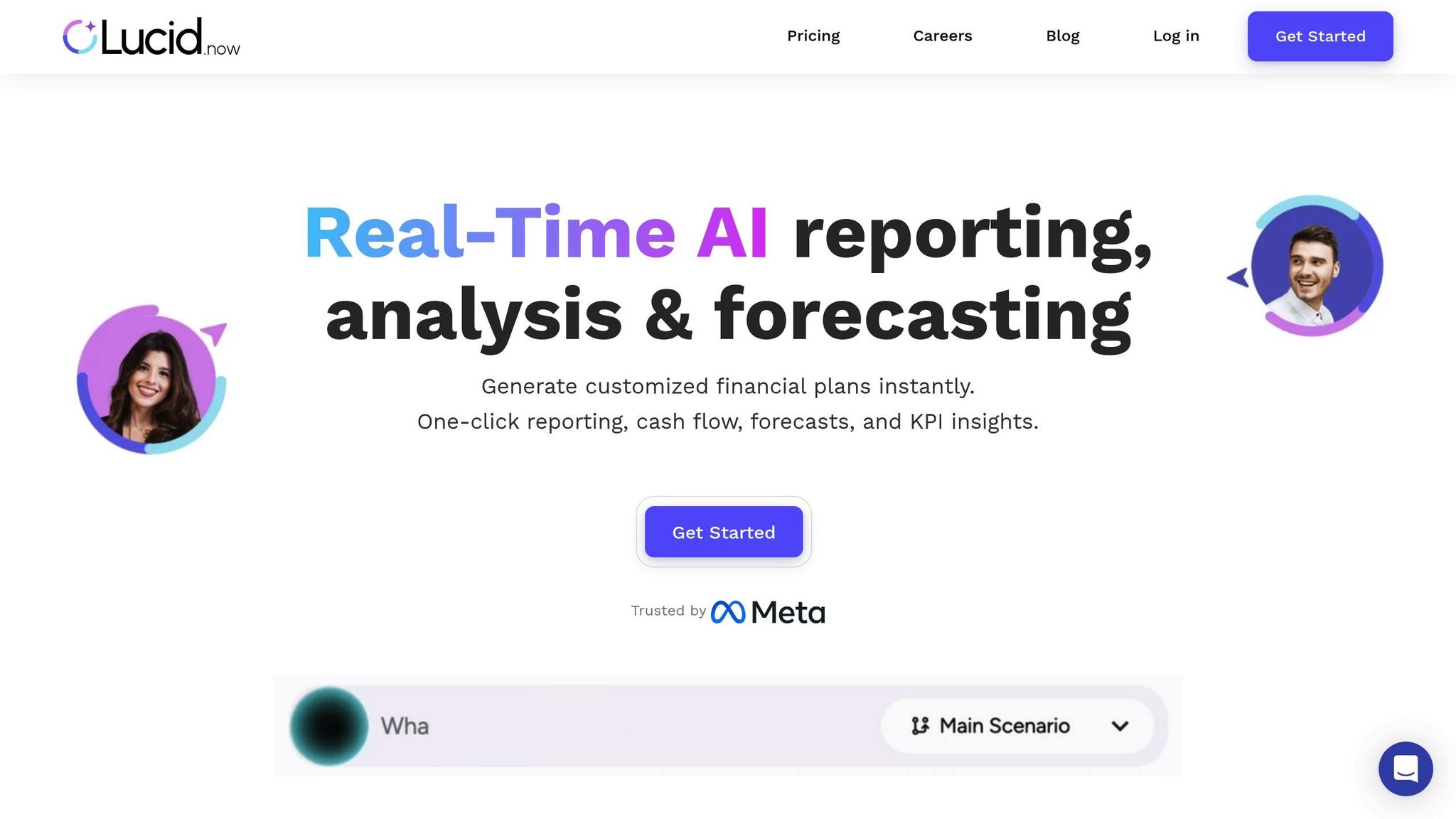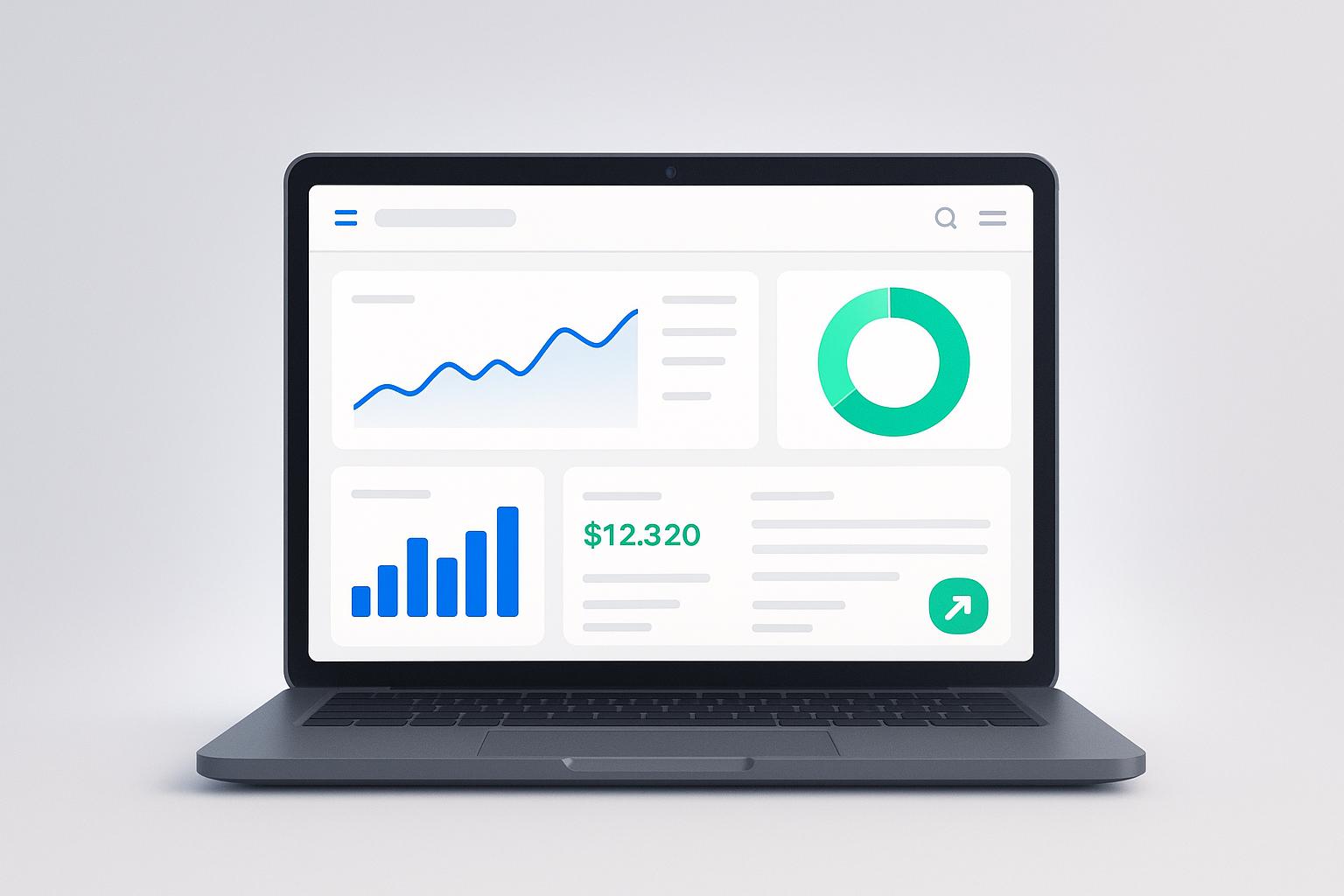Predictive AI helps businesses sell more to existing customers by analyzing data like purchase history and behavior. It increases revenue by identifying the best products to offer, the right timing, and the most likely buyers. For example, companies like Starbucks and Amazon use AI to recommend purchases, which contributes to significant sales growth - 35% of Amazon’s sales come from these recommendations.
Key benefits of AI-powered cross-selling:
- Higher Revenue: Increases cross-sell revenue by 15–25%.
- Better Conversion Rates: Success rates can double compared to traditional methods.
- Customer Personalization: Tailored offers based on behavior and preferences.
- Efficiency: Automates data analysis and sales strategies, saving time.
For small businesses, starting with clean customer data and integrating tools like CRM and marketing platforms makes AI implementation easier. Platforms like Lucid Financials simplify this process by syncing financial data and providing real-time insights.
AI cross-selling isn’t just about boosting sales - it builds stronger customer relationships and improves operational efficiency.
Finding Cross-Selling Opportunities with AI
Using Customer Data
Predictive AI has the power to turn raw customer data into practical strategies for cross-selling. By analyzing purchase histories, browsing habits, and customer interactions, AI uncovers opportunities that might otherwise go unnoticed.
Today’s AI platforms use advanced algorithms to process data from a variety of sources, including:
- Customer Relationship Management (CRM) systems
- E-commerce platforms
- Marketing channels
- Transaction histories
- Customer service interactions
For instance, Capital Credit Union implemented an AI model that boosted auto loan acquisitions by $14.7 million and identified $2.6 million in home equity prospects within just six months. These insights help businesses segment customers into highly specific behavioral groups, paving the way for more targeted cross-selling strategies.
Customer Behavior Groups
AI doesn’t just group customers by static demographics - it digs deeper, segmenting them based on predicted behaviors. By analyzing patterns like purchase frequency, product preferences, average transaction value, seasonal buying habits, and responses to past offers, businesses can create cross-sell strategies that feel tailored to each customer.
This kind of behavioral segmentation allows companies to approach customers with offers that align with their habits and needs, making cross-selling efforts more effective and customer-focused.
Purchase Likelihood Scoring
Taking behavioral segmentation further, AI assigns purchase likelihood scores to customers. These scores help businesses prioritize cross-selling efforts by predicting which customers are most likely to buy. The scoring system evaluates multiple factors, such as:
| Component | Analysis Method | Business Impact |
|---|---|---|
| Transaction History | Sequential recommendation algorithms | Predicts the next likely purchase |
| Time Patterns | Time series analysis | Pinpoints the best timing for offers |
| Product Relationships | Collaborative filtering | Recommends complementary products |
| Customer Preferences | Neural networks | Personalizes suggestions |
A great example of this in action is Starbucks. The company uses AI to analyze transaction data and customer behavior, predicting individual customers’ next purchases. This approach has significantly boosted customer engagement and driven revenue growth.
What makes this system even more effective is its ability to refine predictions as new data comes in, improving accuracy over time. By focusing on high-potential customers, businesses can maximize the impact of their cross-selling strategies while minimizing wasted effort.
Setting Up AI Cross-Selling for SMBs
Getting Started Guide
Small and medium-sized businesses (SMBs) can implement AI-powered cross-selling by starting with manageable steps and expanding as they grow. Recent data shows that 75% of SMBs are investing in AI solutions to improve their sales processes.
Here are the key steps to get started:
- Data Preparation: Begin by organizing your customer data, including transaction histories, demographics, and interaction records. Clean, high-quality data is essential for accurate AI predictions.
-
System Integration: Ensure seamless data flow by connecting your tools and platforms. Here's a quick look at integration priorities:
System Type Purpose Integration Priority CRM Platform Customer data management High Sales Software Transaction tracking High Marketing Tools Campaign performance Medium Customer Service Interaction history Medium - Team Training: Train your sales team to understand and use AI insights effectively, so they can make the most of this technology.
Once these foundational steps are in place, you can explore specialized platforms to further enhance and automate your cross-selling processes.
Lucid Financials Integration

Lucid Financials simplifies AI cross-selling by providing real-time financial insights and seamless integration. This platform helps identify profitable cross-selling opportunities while keeping your margins in check.
Some standout benefits include:
- Automated Data Sync: Directly integrates with tools like QuickBooks and payroll systems, ensuring your financial data stays current.
- Real-Time Analytics: Access instant insights into customer purchase behaviors and profitability.
- Scenario Planning: Test different cross-selling strategies and predict their financial outcomes before implementing them.
Setting Up Auto Cross-Selling
With your systems integrated, you can automate personalized cross-selling campaigns to achieve better results. For instance, Coca-Cola used AI-driven marketing automation to cut content creation time by 50% and increase campaign ROI by 20%.
"Today is really about nurturing each customer's self-directed journey because every customer is automatically on a journey with the brand. So, how do you recognize the customer journey that each individual is on? How can you be helpful to them in that moment, and how can you do that at scale? And that's where AI comes in and helps everyone."
- Vijay Chittoor, co-founder and CEO of Blueshift
To make the most of automated cross-selling:
- Personalize Touchpoints: Tailor your messaging across all customer communication channels using AI insights.
- Track Performance: Monitor conversion rates and customer responses to measure success.
- Refine Strategies: Continuously improve your approach based on AI-driven feedback.
- Combine Models: Use cross-sell predictions alongside next-best-offer recommendations to maximize results.
Predicting Cross Selling Opportunities with No-Code Machine Learning
sbb-itb-17e8ec9
AI Cross-Selling Results
AI has proven to be a game-changer in cross-selling, directly influencing revenue growth, customer engagement, and operational efficiency.
Sales and Profit Growth
AI-powered recommendations have led to a 35% increase in cross-selling success rates. For small and medium-sized businesses, this means measurable improvements to their bottom line.
Here’s how key metrics stack up:
| Performance Indicator | Improvement |
|---|---|
| Conversion Rates | 100% increase |
| Lead Quality | 35% improvement |
| Marketing Engagement | 28% higher |
| Cross-sell Revenue | 15–25% growth |
Amazon offers a prime example of AI’s capabilities - 35% of their total sales come from AI-driven recommendations. Beyond boosting revenue, these tools also strengthen customer relationships, making interactions more meaningful.
Better Customer Relations
AI-driven systems enhance cross-selling by personalizing customer interactions. Research from McKinsey indicates that tailored recommendations can increase revenue by 10–30%. By analyzing customer behaviors, AI ensures suggestions feel helpful rather than intrusive.
For example, Spotlight Federal Bank implemented AI-based engagement solutions and, within six months, achieved:
- A 25% rise in cross-sell revenue
- A 30% boost in product adoption
- Noticeable improvements in customer satisfaction
These personalized approaches not only drive sales but also build trust and loyalty, creating long-term benefits for businesses.
Resource Management
Generative AI is also reshaping how businesses manage their resources, with 44% of entrepreneurs using it to streamline sales processes.
"Automate what can be automated. Don't be afraid to leverage generative AI tools as an aide to get things done more efficiently and effectively. Remember that your team's time is valuable; focus on what you're uniquely qualified to do and outsource the rest."
- Steven Gmelin, VP of Digital Sales and Strategy at ALOHA
AI helps businesses maximize efficiency through:
- Automated Lead Scoring: CRM systems powered by AI prioritize leads with the highest likelihood of conversion.
- Inventory Optimization: Smart systems cut stockouts by 25%.
- Customer Support: AI chatbots deliver round-the-clock assistance.
- Marketing Automation: Campaigns are personalized, and ad targeting is fine-tuned for better ROI.
Tracking AI Cross-Selling Success
Tracking the success of AI-driven cross-selling efforts involves focusing on key performance metrics, understanding customer feedback, and continuously refining AI models. These elements work together to maximize revenue and enhance customer engagement.
Performance Metrics
To measure the effectiveness of AI cross-selling, you need to monitor specific key performance indicators (KPIs) that highlight both financial outcomes and customer experience. These metrics provide a clear picture of how well your strategies are working.
Here are the main categories of KPIs to track:
- Revenue Metrics: Keep an eye on cross-sell revenue and the average revenue per account to gauge financial impact.
- Sales Metrics: Look at conversion rates for cross-sell opportunities and the size of those opportunities to evaluate sales performance.
- Customer Success Metrics: Monitor product usage rates and customer satisfaction to ensure your cross-selling efforts are resonating with customers.
- Operational Metrics: Assess how effectively the strategy is being implemented and the level of participation from your sales team.
By combining these metrics with deeper customer insights, you can fine-tune your cross-selling strategies for even better results.
Customer Response Data
While numerical data is important, understanding customer interactions provides a deeper layer of insight. Analyzing how customers respond to cross-selling efforts can reveal what’s working and what needs adjustment. For example, a retail company using conversational AI saw a 20% revenue increase by tracking specific metrics like query resolution, conversion improvements, and sentiment changes.
Key insights include:
- Interaction Analysis: AI systems resolved 70% of customer queries without human assistance, showcasing their efficiency.
- Conversion Tracking: Lead conversion rates jumped from 10% to 18%, highlighting the effectiveness of AI-driven recommendations.
- Sentiment Analysis: Evaluating customer sentiment helped refine strategies and improve the overall approach.
These insights demonstrate how customer feedback can directly contribute to better cross-sell performance.
AI Model Updates
To maintain and expand the benefits of AI cross-selling, regularly updating and refining AI models is crucial. For instance, banks that adopted advanced personalization techniques experienced a 30% boost in revenue from existing customers.
Here’s how to keep your AI models sharp:
-
Set a Baseline
Begin by tracking initial performance metrics to establish benchmarks for measuring progress. -
Embrace Continuous Learning
Update models to account for factors like emotional states, purchase timing, seasonal trends, and interaction contexts. -
Optimize Performance
Properly timed offers can increase conversion rates by up to 300% compared to generic approaches. To achieve this, focus on:- Regularly retraining AI models with updated data.
- Conducting A/B tests to refine cross-selling strategies.
- Incorporating new patterns in customer behavior.
- Adjusting recommendation algorithms based on fresh insights.
Conclusion: Making AI Cross-Selling Work
Predictive AI is proving to be a game-changer for businesses aiming to grow efficiently. Recent studies reveal that AI-driven cross-selling strategies can boost sales by 20% and increase overall revenue by 10–30%. A standout example is Lucid Financials, which seamlessly integrates AI to provide real-time financial insights.
"Deep relationships with customers are the difference-makers when it comes to challenging sales environments" - Ketan Karkhanis, EVP and GM of Sales Cloud at Salesforce.
The results speak for themselves. Lucid Financials uses proven models to consolidate data and automate personalized recommendations. By integrating with tools like QuickBooks and payroll platforms, it simplifies the process of identifying and acting on cross-selling opportunities.
Here’s how Lucid Financials can help:
- Spot high-potential opportunities through advanced data analysis.
- Deliver tailored recommendations based on customer behavior.
- Monitor and refine cross-selling efforts with real-time performance metrics.
- Automate targeted offers across multiple channels, saving time and effort.
The impact is clear: 83% of sales teams leveraging AI report revenue growth, while sales reps are 2.4 times less likely to feel overburdened.
"AI is no longer a nice to have - it's a must" - Amber Armstrong, Sales Cloud CMO
FAQs
How can small and medium-sized businesses use predictive AI to improve cross-selling without requiring significant resources?
Small and medium-sized businesses (SMBs) can tap into predictive AI to step up their cross-selling game by focusing on practical, easy-to-scale solutions. AI tools excel at analyzing historical customer data to spot purchasing trends and preferences. This means businesses can offer personalized product recommendations and craft targeted marketing strategies, which not only improve customer engagement but also drive sales.
To begin, SMBs can explore budget-friendly AI tools that work smoothly with their current systems, such as financial planning software or CRM platforms. These tools can automate cross-selling efforts - think AI-powered chatbots that deliver tailored product suggestions during live customer interactions. By starting with smaller, manageable AI projects and expanding over time, SMBs can adopt effective cross-selling strategies without stretching their resources too thin.
What types of customer data are most important for using predictive AI to improve cross-selling?
To make the most of predictive AI for cross-selling, businesses should zero in on customer data that sheds light on buying habits and preferences. Start with purchase history - it’s a goldmine for spotting complementary products or services based on what customers have bought before. Then, consider customer demographics like age, gender, and location. These details often hint at specific preferences and shopping behaviors.
Don't overlook behavioral data either. Tracking website activity and product interactions can reveal what customers are eyeing or might buy next. Add to that feedback and reviews, which provide direct insight into customer needs and likes. Finally, dig into loyalty program details - these often highlight your most valuable customers and their spending trends.
By tapping into this data, predictive AI can craft tailored recommendations that not only boost engagement but also drive sales.
How can predictive AI strengthen customer relationships and increase sales through cross-selling?
Predictive AI empowers businesses to deepen customer connections and drive sales by leveraging data to uncover cross-selling opportunities. By studying customer behavior and preferences, it provides personalized product recommendations that align with each individual's needs. This customized approach not only improves customer satisfaction but also nurtures trust and loyalty, making customers feel genuinely valued.
On top of that, predictive AI helps businesses segment their customer base and deliver targeted offers at the perfect moment, increasing the chances of successful cross-sales. When paired with customer relationship management (CRM) tools, it allows companies to engage with customers in a timely and meaningful way. This blend of personalization and proactive outreach fuels sales growth while building lasting relationships.


